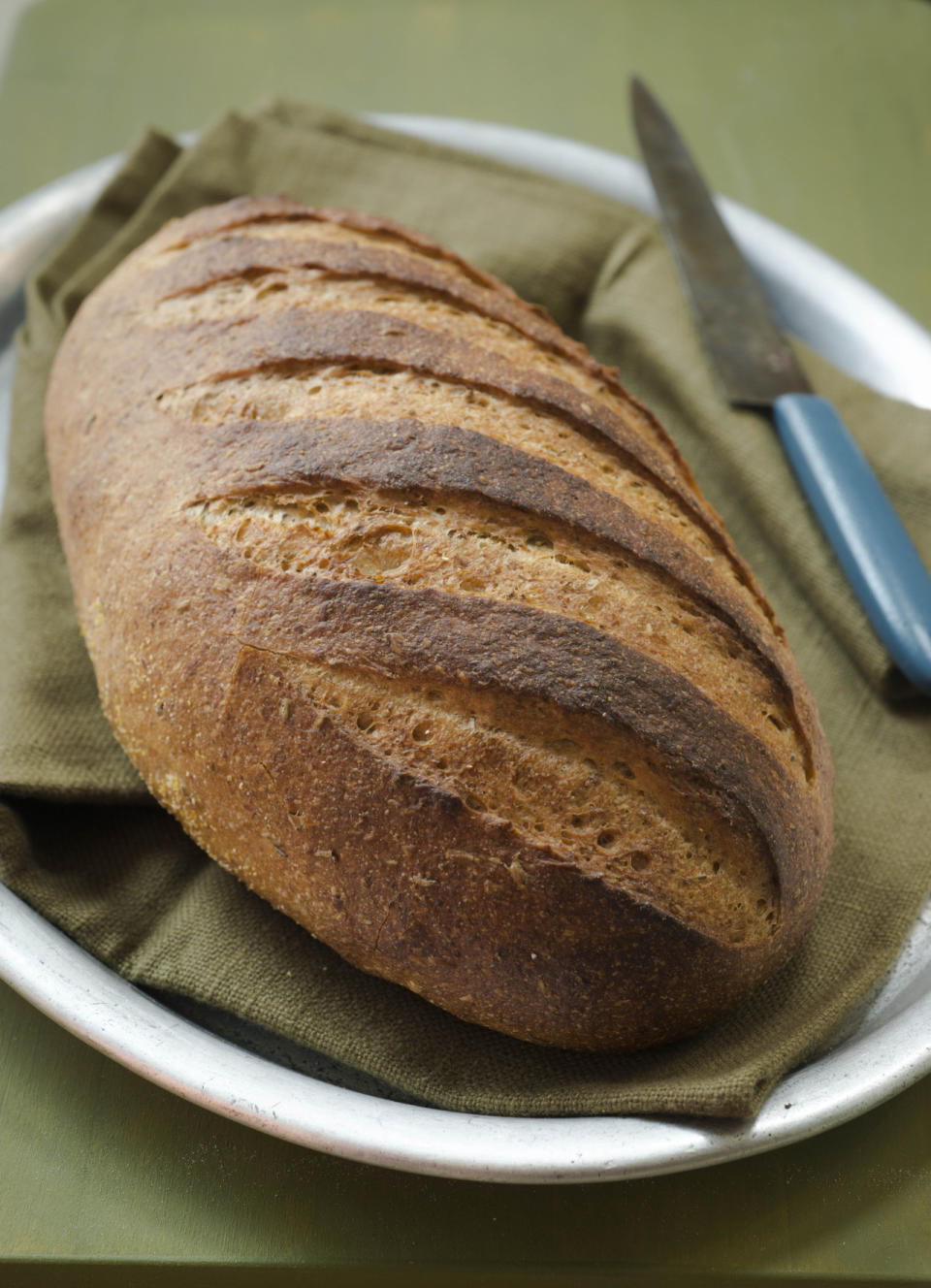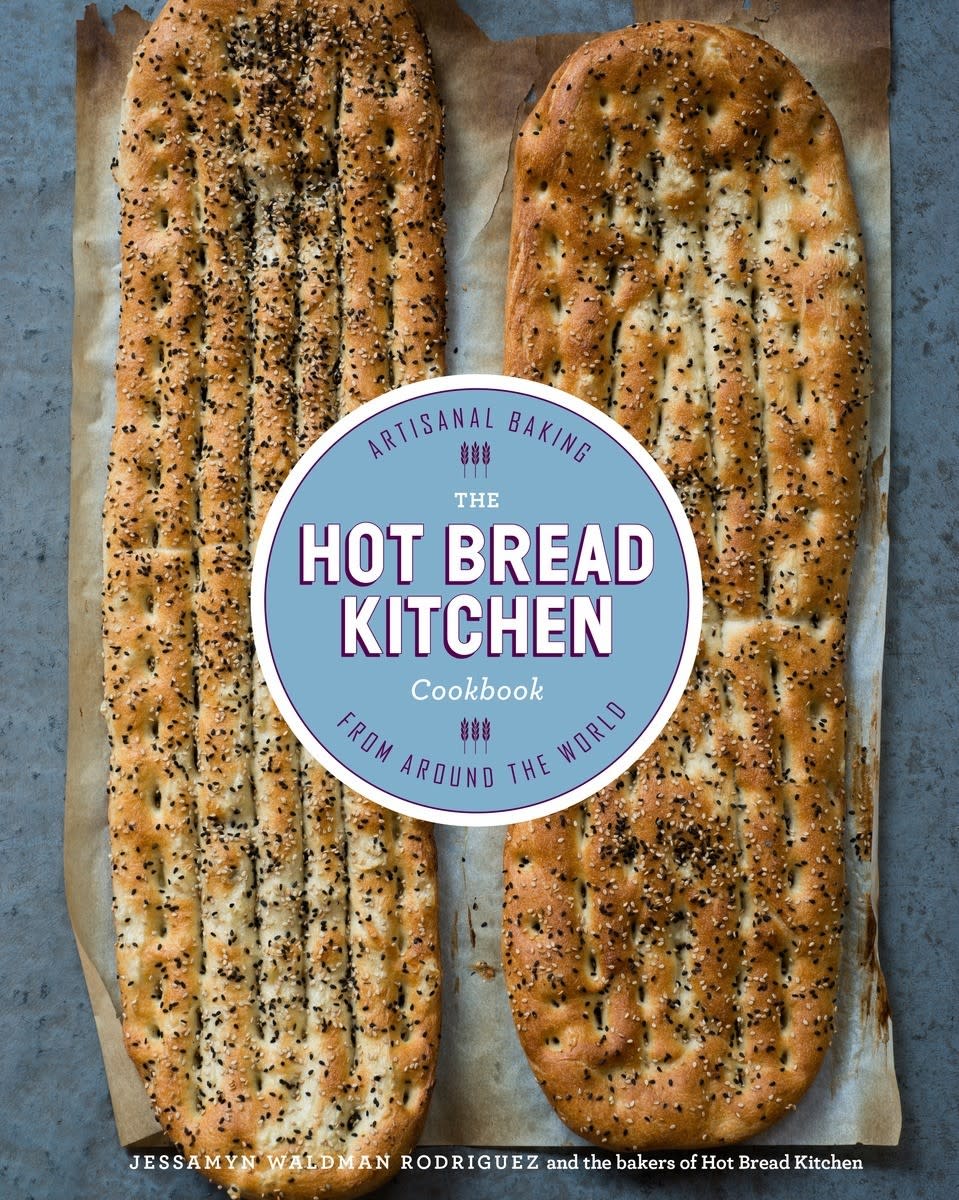New Yorker Rye from ‘The Hot Bread Kitchen Cookbook’
Every week, Yahoo Food spotlights a cookbook that stands out from all the rest. This week’s cookbook is The Hot Bread Kitchen Cookbook: Artisanal Baking from Around the World by Jessamyn Waldman Rodriguez and Julia Turshen. Read more about Yahoo Food’s Cookbook of the Week here.

New Yorker Rye. (Photo: Jennifer May)
by Jessamyn Waldman Rodriguez and Julia Turshen
New Yorker Rye
Makes 2 (10-inch) Loaves
This is the rye bread that you find loaded with pastrami and spicy mustard in New York City’s delis. Our version stands out from the crowd because of the flavor imparted by the pâte fermentée and the high percentage of coarse local rye flour. We developed a killer Reuben sandwich to take advantage of this satisfying bread, though it’s also great to use for a simple grilled cheese with sharp cheddar. The scoring on this bread is important for both structure development and aesthetic. Practice five firm, confident slashes to get the real New York bakery look on these classic loaves.
2 ¾ cups bread flour, plus more for shaping
2 ¾ cups rye flour
Scant 2 cups water
1 ⅔ cups (risen and deflated) pâte fermentée (see recipe), cut into walnut-size pieces (you’ll need to double the recipe)
1 tablespoon plus 1 teaspoon Kosher salt
¼ teaspoon active dry yeast
2 tablespoons caraway seeds
Canola oil
Combine the bread flour, rye flour, and water in a stand mixer fitted with a dough hook. Mix on low speed until combined, 2 minutes. Let rest for 20 minutes to give the flours time to hydrate.
Add the pâte fermentée, salt, and yeast. Mix on low speed until the ingredients are fully combined, about 2 minutes. Increase the speed to medium to medium-high and mix until the dough is smooth, pulls away from the sides of the bowl (and leaves the sides clean), has a bit of shine, and makes a slapping noise against the sides of the bowl, 5 to 6 minutes. The gluten should be fully developed; you are looking for a shiny and smooth dough. You will know it is ready when you lightly tug a piece of the dough and it doesn’t pull right off—it snaps back. Add the caraway seeds and mix for 1 minute more to integrate.
Coat the inside of a large bowl with oil and transfer the dough to it. Cover with plastic wrap (or put the whole bowl into a large plastic bag) and let stand at room temperature until the dough is puffy, supple, and very soft to the touch, about 1 hour. (Note that because this dough has a lot of pre-ferment, it is not an ideal dough to let rise overnight in the fridge.)
Line a pizza peel or the underside of a rimmed baking sheet with parchment.
Turn the dough out onto a lightly floured work surface and divide it into 2 equal pieces (each weighing about 27 ounces). Preshape each piece of dough into a loose boule (see below). Let rest for 15 minutes.
Working with one at a time (and leaving the other under loose plastic wrap), seam side up, flatten your dough slightly and shape into a log roll. Now you want to make your log roll look like a batard with rounded ends (see below) measuring about 10 inches long, 4 inches wide, and about 3 inches tall. There should be one long seam along the bottom of the loaf. Apply slight downward pressure with the pinky side of your hands to round the ends. Repeat the process with the second piece of dough.
Put the loaves, seam side down, on the lined baking sheet. Put the entire pan in a large plastic bag or cover the loaves loosely with plastic wrap and let them rise until the loaves are soft and plump, about 1 hour. If you touch a loaf lightly, it should hold an indentation.
Meanwhile, put a pizza stone on the middle rack of the oven and preheat to 500°F. Set a baking dish in the bottom of the oven.
Use a bread lame or very sharp paring knife to score 5 (2-inch) long parallel slashes on an angle on the top of one loaf. Slide the dough and the parchment onto the pizza stone in one swift movement. Put 10 ice cubes in the baking dish at the bottom of the oven (this will create steam) and reduce the oven temperature to 450°F. Put the other loaf, covered tightly, in a cool place.
Bake until the bread is browned on top and darker brown along the score lines and the loaf sounds hollow when you tap it on the bottom, about 25 minutes. Transfer to a wire rack to cool completely. Meanwhile score and bake the second loaf.
Store bread that will be consumed within 24 hours in a paper or cloth bag. After that, store in plastic bag at room temperature.
To Form Dough Into a Roll:
To form a boule, roll, or bun, or a round preshape, divide the dough evenly and gently form the pieces into rough rectangles. With the dough lying flat on the work surface, gather the corners to the center of the dough—you’ll have a little bundle. Pinch the place where the 4 corners meet. Once you have done that, gather the new edges to your pinch, creating more surface tension. You will have a little beak where your corners came together and, when you pick it up, you should have a nice, smooth round ball. Put the bundle beak side down on the work surface and use your palm to lightly round the ball. Use the pinky edge of your hand to tighten the surface tension even more.
To Form Dough Into a Batard:
To form a batard (a free-form loaf that is wide at the center and slightly tapered at the edges, such as New Yorker Rye), first preshape as a boule (see above). Let rest for 10 minutes. Turn the dough seam side up, flatten it slightly, then form a log roll. Lengthen your loaf to the desired length by rocking it on the table. With the outer edges of your hands, apply pressure to the ends of the dough to taper them.
Pâte Fermentée
Makes about 1 ¼ cups (risen and deflated)
Pâte fermentée is an ingredient in many recipes in the lean and enriched doughs chapters. You need to make it 8 to 24 hours before you bake your bread. This extra step extends fermentation time and allows you to achieve a light, flavorful loaf with less yeast. Pâte fermentée contains the ingredients of simple French bread dough—flour, water, yeast, and salt—so, in a pinch, you could bake and eat it. Unlike other types of pre-ferments, such as levain, pâte fermentée does not impart a sour flavor to the bread. Instead it adds depth of flavor and extends the shelf life of your bread. If you make bread often, you can save the trimmings from lean doughs to use in your pâte fermentée. More likely, you will mix a batch of the pâte fermentée the day before, then refrigerate it until you are ready to bake.
½ cup plus 1 teaspoon lukewarm water
⅔ teaspoon active dry yeast
1 ⅓ cups plus 1 tablespoon bread flour
1 teaspoon kosher salt
Put the water and yeast in the bowl of a stand mixer fitted with a dough hook, then add the flour and salt. Mix on low speed for 2 minutes until combined into a shaggy dough. Cover the bowl with plastic wrap and let stand at room temperature for 30 minutes.
Refrigerate the mixture for a minimum of 8 hours and a maximum of 24. (There is no need to return it to room temperature before using.)
If you’re measuring the pâte fermentée rather than weighing it, be sure to deflate it with a wooden spoon or with floured fingertips before measuring.
Reprinted with permission from The Hot Bread Kitchen Cookbook: Artisanal Baking From Around the World by Jessamyn Waldman Rodriguez and the bakers of Hot Bread Kitchen (Clarkson Potter).

The Hot Bread Kitchen Cookbook: Artisanal Baking from Around the World by Jessamyn Waldman Rodriguez and Julia Turshen. (Photo: Jennifer May)
For awesome baking inspiration check out our Pinterest and get to pinning!
Get your bake on with more bread recipes:
The Bread That Will Change Your Whole World
How to Make Buttery, Flaky Moroccan Bread M’smen
Nan-E Qandi from ‘The Hot Bread Kitchen Cookbook’

